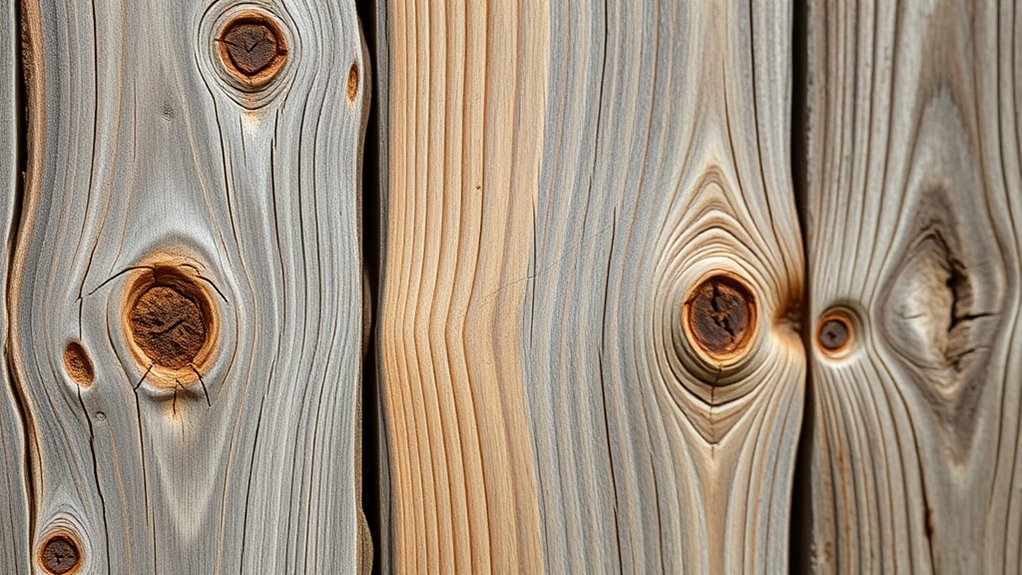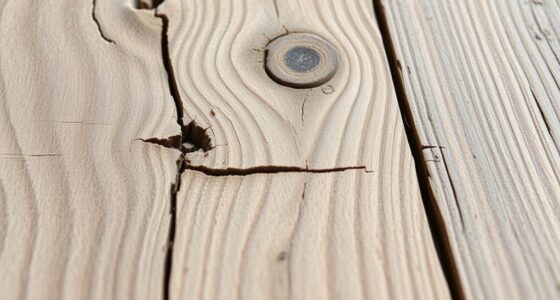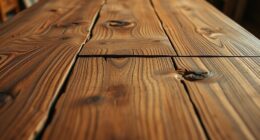To ensure reclaimed barnwood is safe for indoor use, check its source and treatment history. Look for signs of mold, pests, or decay, and take into account testing for hazardous substances like lead. Most reclaimed wood is naturally safe if properly cleaned, sanded, and confirmed free from chemicals or toxins. If you want to learn how to evaluate and prepare barnwood for your space, there’s more to consider for a safe, eco-friendly choice.
Key Takeaways
- Verify the wood’s source and treatment history to ensure it hasn’t been exposed to harmful chemicals or pesticides.
- Inspect for mold, pests, or decay, and test for hazardous substances like lead paint before indoor use.
- Confirm the reclaimed barnwood has been properly cleaned, sanded, and free of surface contaminants.
- Choose wood from reputable suppliers who provide information on eco-friendly and chemical-free preservation methods.
- Ensure the wood has been properly stored and maintained to prevent mold, pests, or deterioration over time.

Have you ever considered how reclaimed barnwood can transform your space? Not only does it add rustic charm and character, but it also offers a sustainable way to enhance your home. When choosing reclaimed barnwood, a key concern is ensuring it’s safe for indoor use. This starts with understanding how the wood has been preserved and whether it’s free from harmful chemicals. Wood preservation plays a vital role here; untreated, properly reclaimed barnwood typically doesn’t require chemical treatments, making it safer for indoor environments. However, some reclaimed wood may have been exposed to pesticides, preservatives, or finishes that could pose health risks. It’s essential to verify the source and treatment history of the wood before installing it indoors.
Reclaimed barnwood adds rustic charm safely when properly preserved and chemical-free.
Assessing the environmental impact of your reclaimed barnwood is equally important. Reclaimed wood is celebrated for its eco-friendliness because it repurposes older materials rather than harvesting new timber, reducing deforestation and waste. Choosing barnwood that has been carefully reclaimed and cleaned minimizes environmental harm and supports sustainable practices. When sourcing reclaimed barnwood, ask about its history—was it salvaged from barns that were safely deconstructed? Has it been treated with environmentally friendly methods? These questions help ensure your choice aligns with eco-conscious values and minimizes negative environmental effects.
Before bringing reclaimed barnwood into your home, you should inspect it thoroughly. Look for signs of mold, pests, or decay, which could compromise indoor air quality or structural integrity. It’s also wise to have the wood tested for lead paint or other hazardous substances, especially if it’s older or sourced from regions with lax safety regulations. Proper cleaning and, if necessary, gentle sanding can remove surface contaminants and dust, further ensuring the wood’s safety indoors. Additionally, understanding the environmental impact of your reclaimed wood can help you make more sustainable choices. If you’re uncertain about the wood’s history or treatment, consulting with a professional or a reputable supplier can give you peace of mind.
In addition, consider the longevity and maintenance of reclaimed barnwood. Properly cleaned and treated barnwood can last for decades indoors, providing a durable and attractive feature. Its natural aging process, when managed correctly, adds to its charm without compromising safety. Ultimately, choosing reclaimed barnwood that has been ethically sourced, thoroughly inspected, and appropriately prepared guarantees a safe, environmentally responsible addition to your home. This way, you enjoy the rustic beauty and sustainability benefits without worry.
Frequently Asked Questions
Can Reclaimed Barnwood Contain Hidden Pests or Insects?
You might wonder if reclaimed barnwood contains hidden pests or insects. To guarantee safety, perform a thorough pest inspection before bringing it inside. Look for signs like small holes, sawdust, or insect activity. Regular insect prevention methods, such as sealing the wood and keeping your space clean, help prevent pests from taking hold. Taking these steps minimizes the risk of hidden pests and keeps your indoor environment safe.
What Are the Environmental Impacts of Using Reclaimed Barnwood Indoors?
Using reclaimed barnwood indoors positively impacts the environment by promoting sustainable sourcing and reducing your carbon footprint. When you choose reclaimed wood, you reuse existing materials instead of harvesting new trees, conserving natural resources. This process minimizes waste and lowers energy consumption associated with manufacturing new wood products. By opting for reclaimed barnwood, you support eco-friendly practices, helping to protect forests and reduce environmental degradation while adding rustic charm to your space.
How Long Does Reclaimed Barnwood Typically Last Indoors?
Think of reclaimed barnwood as a fine wine—it improves with age when cared for properly. Typically, it lasts 20-50 years indoors, depending on moisture resistance and UV stability. If you keep it dry and out of direct sunlight, it will stand the test of time. Proper sealing and maintenance help preserve its beauty and integrity, ensuring your reclaimed wood remains a stunning feature in your home for decades.
Are There Any Health Risks Associated With Reclaimed Barnwood?
You might wonder if reclaimed barnwood poses health risks indoors. Generally, it’s safe, but you should consider indoor air quality and chemical treatments. Some barnwood may have been treated with preservatives or paints that release VOCs, which can affect air quality. To stay safe, make certain the wood is properly cleaned, sealed, and sourced from reputable suppliers who test for harmful chemicals. This helps reduce potential health risks.
Can Reclaimed Barnwood Be Treated or Sealed for Added Safety?
You can definitely treat or seal reclaimed barnwood for added safety. Chemical treatments like non-toxic sealants help lock in harmful substances, while sealing methods such as oil or polyurethane create a protective barrier. Make sure to choose eco-friendly options that are safe for indoor environments. Properly sealing the wood reduces dust and chemical emissions, making your reclaimed barnwood both beautiful and safe for indoor use.
Conclusion
When choosing reclaimed barnwood for indoor use, safety is key. Always verify it’s free from pests, mold, and harmful chemicals. Did you know that up to 80% of older barnwood can contain lead paint or other toxins if not properly tested? By taking these precautions, you guarantee your space remains beautiful and safe. Reclaimed barnwood not only adds rustic charm but also preserves history—just make sure it’s properly inspected before bringing it inside.











